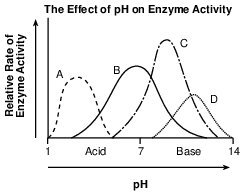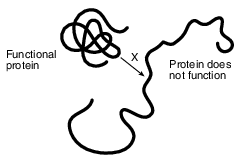Topic: Enzymes Hormones Receptor And Antibodies
Enzymes Hormones Receptor And Antibodies
The Venus flytrap is a plant that uses specialized leaves in order to capture and digest small insects.

Enzymes secreted by cells in the leaves of the Venus flytrap can digest
(1) proteins into amino acids
(2) sugars into starches
(3) amino acids into fats
(4) proteins into sugars
Photosynthesis and respiration are alike in that they both
(1) require the Sun as a direct source of energy
(2) result in the production of glucose molecules
(3) require specific catalysts
(4) occur within mitochondria
Which statement is most likely correct regarding soil bacteria that inhabit the polar regions of Earth?
(1) They do not carry out the process of respiration.
(2) They contain enzymes that function at low temperatures.
(3) They are part of the abiotic resources of that ecosystem.
(4) They do not reproduce.
In living cells, chemical processes, such as synthesis, all require the action of
(1) specialized antibiotics
(2) hormones
(3) salts
(4) biological catalysts
Many disorders are due to the inability of an individual to break down a particular chemical. Sometimes these disorders can be treated by giving the affected individual the appropriate
(1) enzymes
(2) antigens
(3) chromosomes
(4) organelles
The Venus flytrap is a plant that has a unique system by which it traps and breaks down its prey. Unsuspecting insects land on the leaf and touch tiny hairs located on the leaf, triggering the leaf to close around the prey.

The substance responsible for breaking down the Venus flytrap’s prey most likely contains
(1) chlorophyll molecules
(2) glucose molecules
(3) hormone molecules
(4) enzyme molecules
Students did an experiment comparing the activity of four different enzymes, A, B, C, and D. The results are represented in the graph below.

A valid conclusion based on the information in the graph is that
(1) the pH of some enzymes changes as the temperature changes
(2) enzymes change color in proportion to the rate of activity
(3) a difference in the pH of an environment changes enzyme activity
(4) enzyme activity causes acids to change into bases over time
The diagram below represents a model of a biological process that occurs in humans at normal body temperature, 37°C.

Increasing body temperature to 40°C would interfere most directly with the rate of function of structure
(1) A
(2) B
(3) C
(4) D
Which statement explains the importance of maintaining a constant internal environment to ensure proper enzyme functioning?
(1) Changes in pH and temperature will cause the enzyme reaction rate to be too fast.
(2) Temperature and pH determine amino acid sequences in enzymes.
(3) Changes in pH will change the genetic instructions of enzymes.
(4) Increasing the temperature and pH can alter the specific shape of enzymes.
The graph below represents the effect of pH on three different enzymes at normal body temperature.

The graph illustrates that enzymes 1, 2, and 3
(1) are not affected by pH
(2) work best at different pH levels
(3) work best in an acidic environment
(4) work best in a basic environment
In the diagram below, X represents a process that causes a protein to unfold and stop functioning.

Process X is most likely caused by
(1) the digestion of the amino acids that make up the proteins
(2) the synthesis of a protein with different simple sugars
(3) removal of the gene that codes for the production of the protein
(4) an internal factor in the body, such as a temperature increase

Based on the diagram, the process of glycolysis most likely
(1) begins the breakdown of glucose
(2) produces oxygen for organisms to use
(3) stores energy in molecules of water and carbon dioxide
(4) recycles glucose within the cells of simple organisms

Describe one role of enzymes in the human body. [1]
Allow 1 credit. Acceptable responses include, but are not limited to:
• — Enzymes catalyze chemical reactions.
• — Enzymes affect the rate of chemical reactions.
• — They help synthesize proteins.
• — Enzymes speed up digestion.
An accident resulted in a man’s hand being cut off from his arm. Paramedics arriving first on the scene placed the cut-off hand in ice. The man and his hand were flown to a hospital, where doctors successfully reattached the hand to his arm. Explain, using one biological reason, why placing the hand in ice improved the chances of saving it. [1]
Allow 1 credit. Acceptable responses include, but are not limited to:
• — Cooling would slow down any tissue decomposition/breakdown that may otherwise occur.
• — Cooling the enzymes in the cells of the hand causes the metabolic rate to decrease. This
• extends cell lifetime without additional blood and oxygen supply.
• — The cooling would slow the action of enzymes that could cause tissue damage.
• — to slow down growth of bacteria on the tissue
• — to preserve it, so it does not rot
• Note: Do not accept just “to preserve it” without a biological reason.
Enzyme Investigation
An enzyme was isolated from digestive juices taken from the small intestine. An experiment was set up to test the ability of the enzyme to break down protein. Two test tubes, labeled A and B, were placed in a hot water bath at 37°C, human body temperature.
Test tube A contained only protein and test tube B contained protein and the enzyme. The chart below shows the set-up.

After two hours, the contents of both test tubes were analyzed. Test tube A showed only the presence of protein. Test tube B showed the presence of the end products of protein digestion, indicating the enzyme had successfully broken down the protein.
Explain the importance of temperature in the functioning of enzymes. [1]
Allow 1 credit. Acceptable responses include, but are not limited to:
• — Each enzyme works best within a specific range of temperatures.
• — If the temperature is too high/low, the enzyme might not function.
• — The enzyme could be denatured/change shape at some temperature.
• — The enzyme is a human enzyme and works best at body temperature.
• — Temperature affects the rate of reaction/enzyme activity.
